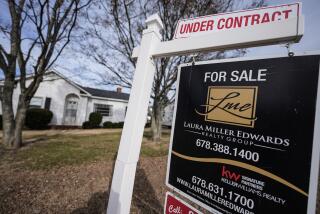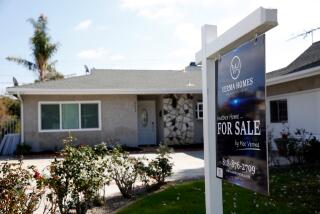Extra Effort Can Speed Home Sale
- Share via
In a buyer’s market--or anytime you’re having trouble selling your home--you need to do extra work to attract a buyer. Some steps involve spending money or making price concessions; still others mean adopting creative marketing techniques. Ideally, you take these actions before you list your home to achieve a quick sale. But you can also implement them later, if your home fails to sell.
When you are not getting buyer traffic or offers, ask your agent why, or--if you’re selling on your own--make follow-up phone calls to prospects to find out their reactions. Certain situations may be hindering a successful sale, including problems with the property, drawbacks with the neighborhood, overpricing or an ineffective selling broker or agent.
Problems With the Property
Perhaps a lack of curb appeal, interior defects, poor condition or property flaws are limiting interest. Maybe there’s a dilapidated fence that needs repairing, too many trees or noise from the road that could be deadened with a fence or landscaping.
Do an informal survey among neighbors and friends, asking them to give you an honest assessment of your home and property. They can be more objective than you can, and most will have some thoughts about what needs to be changed. Give priority to any problem or improvement that is mentioned more than once.
Unusual colors, for example, create a negative first impression that is hard to overcome. Houses painted or sided in unusual or outdated colors do not sell easily. Some colors, such as dark purple or lime green are almost always unattractive. Others, such as pink or lavender, look fine in parts of the West and Florida, but are out of place on a Colonial or split-level. Repaint or, if necessary, re-side your home. If your home has other unusual or unattractive features, consider whether they can be eliminated, de-emphasized or changed.
Don’t overlook the yard and landscaping. A paved-over back yard can be dug up and planted with seed or sod fairly inexpensively; a broken or gravel front walkway can be repaired or replaced with flagstones, bricks or tinted and patterned concrete.
Except for repainting or re-siding, don’t spend more than a couple of thousand dollars on cosmetics; adding imported granite countertops or tiled back-splashes featuring custom artwork is a waste of money. Stick to the basics, since buyers may not like your taste or may not appreciate expensive materials. The main tips to remember are to paint inside and out, make all needed repairs, freshen up landscaping and clean thoroughly.
Drawbacks With Neighborhood
Are there potholes in your street, or are you near an overgrown vacant lot?
If something about your neighborhood is bothering buyers, you may be able to correct the problem or at least improve the situation. Of course, a nearby industrial plant or a foul-smelling landfill or river can’t be changed. But eyesores such as an empty lot, a neglected traffic island, a pothole-riddled street or a rundown playground can be improved, with the cooperation of your neighbors. Point out to them how fixing the problem--either by soliciting your town to appropriate funds, collecting donations from residents or volunteering labor--will benefit everyone by making the street a more attractive place to live and thereby increasing everyone’s property values.
Overpricing
If buyers’ and agents’ reactions to your home are favorable, but you are not receiving offers or are getting only low bids, your price may be too high. If you are serious about selling, you will have to reduce your expectations. Price reductions do work; people like to feel they are getting a bargain, and the new selling price will bring in new buyers and agents. It may also stimulate previous lookers to make an offer. If it’s any comfort, you will save some money on commission costs as well.
How much you choose to lower the price, and how long you should wait before doing so, depends on your home’s general price range, how quickly you want to sell, the state of the market and how realistic the price was originally.
If you set a price that was 15% or 20% higher than your home’s market value, you must drop your price more than if you priced it only 5% higher. This is especially true if the market has deteriorated or if your need to move has become more pressing. Some sellers choose to cut the price in small increments several times over a period of months. Unless your home is priced below $100,000, this strategy can be harmful, chiefly because a home sitting on the market for a long time becomes “stale.” It’s better to make fewer and larger price cuts that attract attention, show you’re serious about selling and make an immediate difference in the ability of buyers to afford your home.
If homes in your area take four to six months to sell and your home’s carrying costs are high, it makes financial sense to reduce your price only once, substantially, to sell it quickly. Example: Your carrying costs for four months total $16,000. Cutting the price $10,000 may get you an immediate sale and you will come out ahead $6,000.
So, as a rule of thumb, if your home is priced at no more than $200,000 but above $100,000, cut $5,000 off the price. For homes priced below $100,000, cut $2,000 to $3,000. If your home is priced between $200,000 and $500,000, go for bigger incremental cuts of $10,000 to $15,000, or more.
If the lower price still doesn’t attract offers, you’ll have to reduce the price again in another month or two. Any home will sell if the price is low enough. But you have to decide how low you are willing to go. If you will lose money on the sale, based on what you paid for the home, and will not make up that loss through equal or greater savings on a trade-up home, you may prefer to sit tight and wait for a buyer (or a better market) than cut your price any further.
Ineffective Broker or Agent
If you’re selling on your own, you can judge the effectiveness of your marketing by the number of inquiries you receive. If you receive very few, check that your ad is complete and highlights your home’s strong points. Or rewrite the ad. Circulate different versions so buyers won’t become too familiar with the house and wonder why it’s on the market so long.
If you’re selling with the help of an agent, you have an idea of how many buyers are visiting your home by the number of calls you get from agents wanting to set up appointments, the number of business cards that agents leave for you and what your agent tells (or doesn’t tell) you.
If the agent is avoiding you, or you rarely get a request for an appointment, ask why. The reasons may be related to problems with the house or the neighborhood or the price, as discussed above. Or perhaps it’s simply a soft market, and you need to be more patient.
Still, this is the time to ask your agent for evidence of what has been done to your market home--your MLS write-up and photo, any ads about your home, a fact sheet--and to ask the agent to increase your home’s exposure in the marketplace. If you see no signs of stepped-up activity within the next month, try to resolve the problem, switch agents or sell on your own.
Once you resolve the obvious problems hindering your home’s marketability, you can offer extra incentives to buyers or agents, and use other marketing tools that give your home a competitive edge or help it sell faster.
More to Read
Sign up for Essential California
The most important California stories and recommendations in your inbox every morning.
You may occasionally receive promotional content from the Los Angeles Times.






